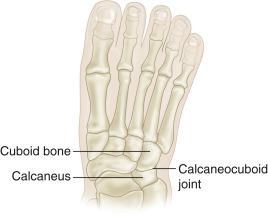Physical Address
304 North Cardinal St.
Dorchester Center, MA 02124
Injuries to the talonavicular and calcaneocuboid joints (Chopart joints) are severe injuries often associated with an abduction force to the talonavicular joint and a lateral compression injury to the lateral column resulting in a “nutcracker” phenomenon.
Precise examination and imaging, including computed tomography scan, are essential to defining the injury pattern and presence of articular incongruity.
Articular subluxation and step-off, loss of lateral column length, and the presence of smaller avulsion fractures need to be adequately identified to define treatment options.
Anatomic restoration of medial and lateral column anatomy is critical in obtaining reduction of these complex injuries.
Reduction and restoration of the articular surface of the talonavicular, naviculocuneiform, calcaneocuboid, and cuboid-4,5 metatarsal joints are essential to good outcomes.
Examination of the soft envelope is critical to success in treating midfoot injuries. All dislocations should be treated acutely with particular attention given to impending skin necrosis.
It is important to maintain motion along the cuboid/metatarsal joints, as these are essential joints, and maintaining motion is critical for normal foot function.
Careful attention should be given to Chopart injuries, as midfoot arthrosis can be disabling, with no great salvage procedure for cuboid-4,5 metatarsal arthrosis.
The role of primary arthrodesis in the treatment of Chopart fracture dislocations has not been well defined.
Primary arthrodesis may play a role in treating severely comminuted injuries or severe injuries with significant bone loss.
Obtain three-view radiographs of the injured and contralateral foot including anteroposterior ( Fig. 23.1A ), oblique ( Fig. 23.1B ), and lateral ( Fig. 23.1C ). The radiographic anatomy of the uninjured extremity is critical in defining normal medial and lateral column anatomy.

Radiographs should precisely identify the anatomy of the medial column and the cuboid-4,5 metatarsal junction. Poor imaging quality can miss impaction injuries and joint incongruity.
Computed tomography, including 3D-reconstruction views, provides a topographical map detailing the injury pattern, articular impaction and displacement, joint subluxation, degree of comminution, and presence of avulsion injuries ( Fig. 23.2 ).

Magnetic resonance imaging is usually not indicated in the evaluation of Chopart injuries.
The navicular articulates proximally with the talus at the talonavicular joint and serves as a socket for the talar head, forming an essential joint that contributes up to 80% of subtalar motion ( Fig. 23.3 ).
Distally, the navicular articulates with the cuneiforms at three separate articulations, forming the nonessential naviculocuneiform joints.
The navicular articulates laterally with the cuboid bone.
The cuboid articulates proximally with the calcaneus at the calcaneocuboid joint and distally with the fourth and fifth metatarsals (see Fig. 23.3 ).

The medial surface of the cuboid articulates with the lateral cuneiform and the navicular.
The plantar surface of the cuboid bone contains the peroneal sulcus, a groove through which the peroneal longus passes.
The patient can be positioned supine with a bump placed beneath the knee and hip to control access to the medial and lateral columns of the foot.
A lateral position with a foam wedge can be used when the injury is isolated to the lateral column or during access to the cuboid bone if the surgery is being staged.
Lesser degrees of internal rotation are desired if a medial column injury is being treated simultaneously.
Become a Clinical Tree membership for Full access and enjoy Unlimited articles
If you are a member. Log in here